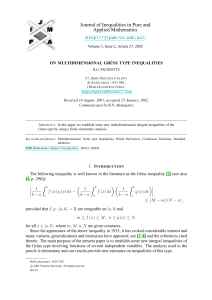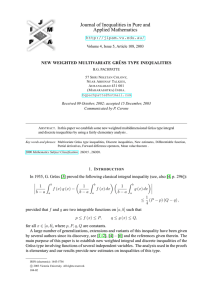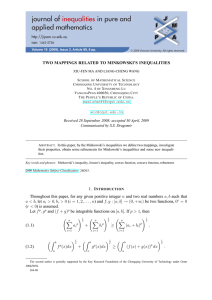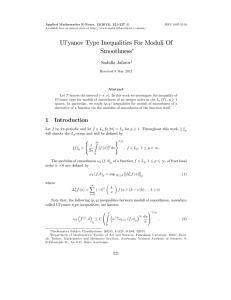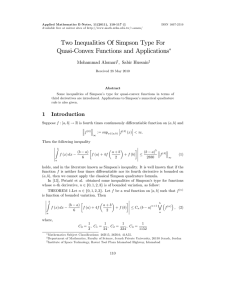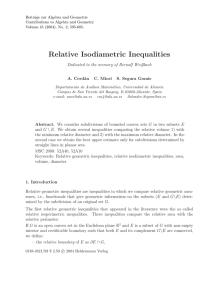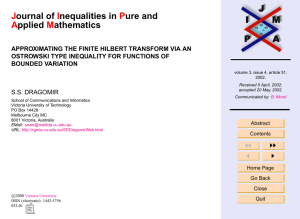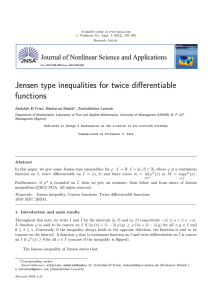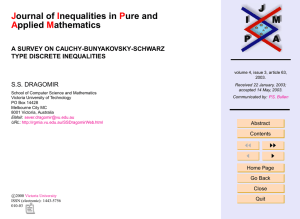Document 10677587
advertisement
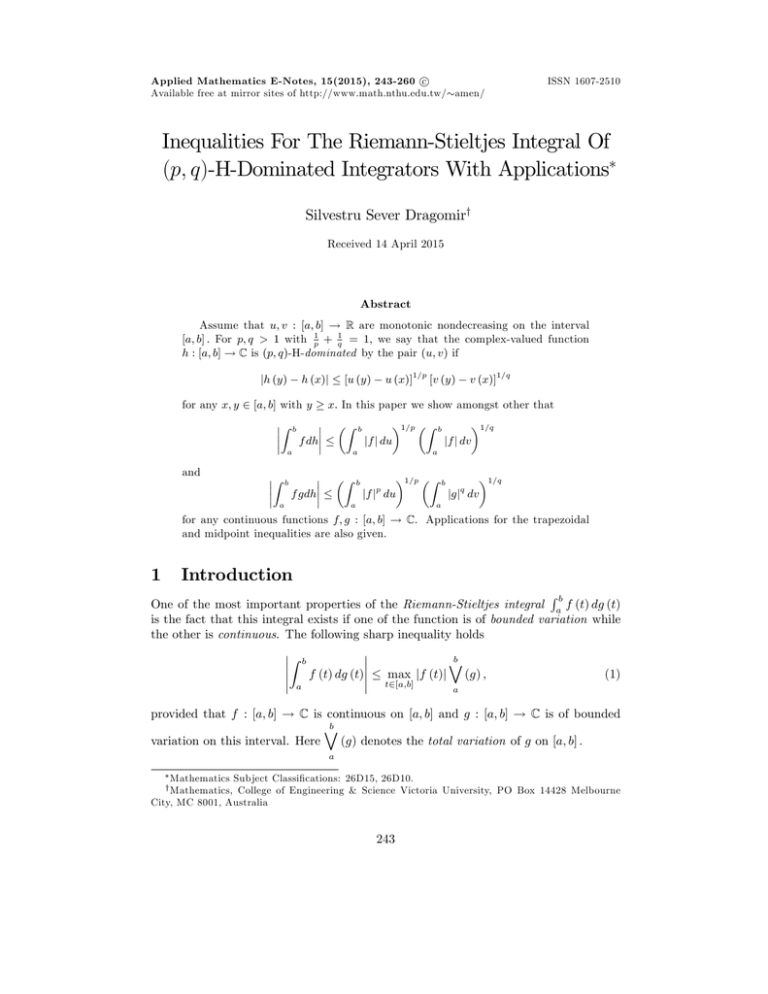
Applied Mathematics E-Notes, 15(2015), 243-260 c Available free at mirror sites of http://www.math.nthu.edu.tw/ amen/ ISSN 1607-2510 Inequalities For The Riemann-Stieltjes Integral Of (p; q)-H-Dominated Integrators With Applications Silvestru Sever Dragomiry Received 14 April 2015 Abstract Assume that u; v : [a; b] ! R are monotonic nondecreasing on the interval [a; b] : For p; q > 1 with p1 + 1q = 1; we say that the complex-valued function h : [a; b] ! C is (p; q)-H-dominated by the pair (u; v) if jh (y) h (x)j for any x; y 2 [a; b] with y Z and Z [u (y) u (x)]1=p [v (y) v (x)]1=q x: In this paper we show amongst other that Z b f dh a Z b f gdh a 1=p b jf j du a b a Z a 1=p jf jp du Z 1=q b jf j dv b a 1=q jgjq dv for any continuous functions f; g : [a; b] ! C. Applications for the trapezoidal and midpoint inequalities are also given. 1 Introduction Rb One of the most important properties of the Riemann-Stieltjes integral a f (t) dg (t) is the fact that this integral exists if one of the function is of bounded variation while the other is continuous. The following sharp inequality holds Z b f (t) dg (t) a max jf (t)j t2[a;b] b _ (g) ; (1) a provided that f : [a; b] ! C is continuous on [a; b] and g : [a; b] ! C is of bounded b _ variation on this interval. Here (g) denotes the total variation of g on [a; b] : a Mathematics Subject Classi…cations: 26D15, 26D10. College of Engineering & Science Victoria University, PO Box 14428 Melbourne City, MC 8001, Australia y Mathematics, 243 244 Inequalities for the Riemann-Stieltjes Integral When g is Lipschitzian with the constant L > 0; i.e., jg (t) g (s)j L jt for any t; s 2 [a; b] ; then we have Z Z b L f (t) dg (t) b a a sj jf (t)j dt (2) for any Riemann integrable function f : [a; b] ! C. Moreover, if the integrator g is monotonic nondecreasing on the interval [a; b] and f : [a; b] ! C is continuous, then we have the modulus inequality Z Z b f (t) dg (t) a a b jf (t)j dg (t) : (3) The above inequalities have been used by many authors to derive various integral inequalities. We provide here some simple examples. The following generalized trapezoidal inequality for the function of bounded variation f : [a; b] ! C was obtained in 1999 by the author [21, Proposition 1] Z b f (t) dt (x a) f (a) (b x) f (b) a 1 (b 2 a+b 2 a) + x b _ (f ) ; (4) a where x 2 [a; b] : The constant 21 cannot be replaced by a smaller quantity. See also [19] for a di¤erent proof and other details. The best inequality one can derive from (4) is the trapezoid inequality Z b f (t) dt a f (a) + f (b) (b 2 a) 1 (b 2 a) b _ (f ) : (5) a Here the constant 21 is also best possible. For related results, see [11–15, 17–20, 24, 25, 29–33, 39, 40, 42–44, 52–54]. In order to extend the classical Ostrowski’s inequality for di¤erentiable functions with bounded derivatives to the larger class of functions of bounded variation, the author obtained in 1999 (see [21] or the RGMIA preprint version of [23]) the following result Z b b a+b _ 1 f (t) dt f (x) (b a) (b a) + x (f ) (6) 2 2 a a for any x 2 [a; b] and f : [a; b] ! C a function of bounded variation on [a; b] : Here Wb 1 a (f ) denotes the total variation of f on [a; b] and the constant 2 is best possible in (6). The best inequality one can obtain from (6) is the midpoint inequality, namely Z a b f (t) dt f a+b 2 (b a) 1 (b 2 a) b _ a (f ) (7) S. S. Dragomir 245 for which the constant 21 is also sharp. For related results, see [1–11, 16, 17, 21, 23, 25–27, 31, 34–38, 41, 45–51, 55–58]. Motivated by the above results, we establish in this paper bounds for the quantities Z Z b f dh and b f gdh a a in the case when the integrands f; g; are continuous while the function of bounded variation h is (p; q)-H-dominated by a pair of monotonic functions in the sense presented at the beginning of the next section. Applications for the trapezoidal and midpoint inequalities are also given. 2 Some General Inequalities Assume that u; v : [a; b] ! R are monotonic nondecreasing on the interval [a; b] : Assume everywhere in what follows that p; q > 1 with p1 + 1q = 1: We say that the complex-valued function h : [a; b] ! C is (p; q)-H-dominated by the pair (u; v) if jh (y) h (x)j 1=p [u (y) u (x)] [v (y) 1=q v (x)] (S) for any x; y 2 [a; b] with y x: We can give numerous examples of such functions. p For instance, if we take f; g two measurable complex-valued functions such that jf j q and jgj are Lebesgue integrable and denote Z x Z x Z x p q h (x) := f (t) g (t) dt; u (x) := jf (t)j dt and v (x) := jg (t)j dt; a a a then we observe that u and v are monotonic nondecreasing on [a; b] and by Hölder integral inequality we have for any y x with x; y 2 [a; b] that jh (y) h (x)j = Z y f (t) g (t) dt 1=p u (x)] [v (y) 1=p y x x [u (y) Z p jf (t)j dt 1=q v (x)] Z y x 1=q q jg (t)j dt : Now, for m; n > 0 if we consider f (t) := tm and g (t) := tn for t 0; then Z x 1 xm+n+1 ; hm;n (x) := tm+n dt = m + n + 1 0 Z x Z x 1 1 um;p (x) := tpm dt = x2pm+1 and vn;q (x) := tqn dt = x2qn+1 2pm + 1 2qn + 1 0 0 for p; q > 1 with p1 + 1q = 1: Taking into account the above comments we observe that the function hm;n is (p; q)-H-dominated by the pair (um;p ; vn;q ) on any subinterval of [0; 1) : 246 Inequalities for the Riemann-Stieltjes Integral PROPOSITION 1. If h : [a; b] ! C is (p; q)-H-dominated by the pair (u; v) ; then h is of bounded variation on any subinterval [c; d] [a; b] and d _ (h) 1=p [u (d) u (c)] [v (d) 1=q v (c)] : (8) c 1 p for p; q > 1 with + 1 q = 1: PROOF. Consider a division of the interval [c; d] given by : c = x0 < x1 < ::: < xn 1 < xn = b: Since h : [a; b] ! C is (p; q)-H-dominated by the pair (u; v) then we have jh (xi+1 ) h (xi )j [u (xi+1 ) 1=p u (xi )] for any i 2 f0; :::; n 1g : Summing this inequality over i from 0 to n inequality we have n X1 i=1 jh (xi+1 ) n X1 1=p u (xi )] i=1 [u (xi+1 ) 1=p u (c)] Taking the supremum over 1 and utilizing the Hölder discrete [v (xi+1 ) !1=p u (xi )] i=1 = [u (d) 1=q v (xi )] h (xi )j [u (xi+1 ) n X1 [v (xi+1 ) [v (d) n X1 1=q v (xi )] [v (xi+1 ) v (xi )] i=1 1=q v (c)] !1=q : (9) we deduce the desired result (8). COROLLARY 1. If h : [a; b] ! C is (p; q)-H-dominated by the pair (u; v) ; then the cumulative variation function V : [a; b] ! [0; 1) de…ned by V (x) := x _ (h) a is also (p; q)-H-dominated by the pair (u; v) : The following result is a kind of Hölder integral inequality for the Riemann-Stieltjes integral: THEOREM 1. Assume that u; v : [a; b] ! R are monotonic nondecreasing on the interval [a; b] : If h : [a; b] ! C is (p; q)-H-dominated by the pair (u; v) and f : [a; b] ! C S. S. Dragomir 247 Rb is a continuous function on [a; b] ; then the Riemann-Stieltjes integral a f (t) dh (t) exists and !1=q !1=p Z Z Z b b b jf (t)j du (t) f (t) dh (t) a a a Rb PROOF. Since the Riemann-Stieltjes integral sequence of partitions (n) (n) In(n) : a = t0 < t1 < tn with the norm v In(n) := (n) max ti+1 i2f0;:::;n 1g (n) i as n ! 1; and for any intermediate points have Z b f (t) dh (t) : (10) f (t) dh (t) exists, then for any a (n) 1 < jf (t)j dv (t) < t(n) n =b (n) !0 (n) (n) ti 2 [ti ; ti+1 ]; i 2 f0; : : : ; n 1g we a = lim (n) v In v n X1 (n) n X1 lim (n) !0 v In lim = Z a h (n) h ti+1 f (n) i h ti+1 f (n) i !0 i=0 v In (n) (n) i (n) h ti (n) h ti (n) u ti i (n) !0 i=0 lim v In f !0 i=0 lim (n) In n X1 !0 n X1 h u ti+1 f (n) i h f (n) i h i=0 n X1 i=0 b !1=p jf (t)j du (t) Z a u (n) ti+1 v (n) ti+1 i1=p h (n) u (n) ti v (n) ti jf (t)j dv (t) !1=q b i (n) v ti+1 !1=p (n) v ti i1=q ! i 1=q ; where for the last inequality we employed the Hölder weighted discrete inequality !1=p n !1=q n n X X X p q mk ak bk mk ak m k bk ; k=1 where mk ; ak , bk k=1 0 for k 2 f1; :::; ng : k=1 (11) 248 Inequalities for the Riemann-Stieltjes Integral We have the following weighted Hölder type inequality for the Riemann-Stieltjes integral as well. THEOREM 2. Let f; g : [a; b] ! C be continuous on [a; b] : If h : [a; b] ! C is (p; q)-H-dominated by the pair (u; v) ; which are monotonic nondecreasing on [a; b] ; then for any continuos nonnegative function ` : [a; b] ! [0; 1) we have Z Z b `f gdh b Z !1=p Z ` jf j du a a !1=p p b q ` jgj dv a !1=q : (12) In particular, for ` = 1 we have Z Z b f gdh b jf j du a a p b a q jgj dv !1=q : (13) Rb PROOF. Since the Riemann-Stieltjes integral a `f gdh exists, then for any sequence of partitions (n) (n) (n) In(n) : a = t0 < t1 < < tn 1 < t(n) n =b with the norm v In(n) := (n) max ti+1 i2f0;:::;n 1g as n ! 1; and for any intermediate points have: Z b `f gdh (n) i (n) !0 (n) (n) ti 2 [ti ; ti+1 ]; i 2 f0; : : : ; n 1g we a = lim (n) n X1 lim v (n) f (n) i h (n) h ti+1 (n) i g ` (n) i f (n) i g (n) i ` (n) i f (n) i g (n) i (n) h ti+1 (n) h ti i (n) h ti !0 i=0 lim v In (n) i ` !0 i=0 v In (n) In n X1 n X1 !0 i=0 (n) u ti+1 (n) u ti 1=p (n) u ti+1 (n) 1=q u ti := I: (14) Utilising the weighted Hölder discrete inequality !1=p n n X X p `k ak bk `k ak k=1 k=1 n X k=1 `k bqk !1=q S. S. Dragomir 249 where `k ; ak ; bk 0 0 for k 2 f1; :::; ng ; we have @ I lim (n) @ lim (n) =@ 0 @ n X1 n X1 lim (n) In v n X1 lim = (n) a ` (n) i f (n) i g (n) i (n) 1=p p (n) u ti+1 q u ti (n) ti+1 v (n) i ` p (n) i f !0 i=0 (n) i ` (n) i g b !1=p p Z ` jf j du b q ` jgj dv a h h q !0 i=0 v In Z (n) i v (n) (n) u ti+1 u ti (n) (n) v ti+1 !1=q 1=q q (n) ti !0 i=0 v In 0 ` p !0 i=0 v In 0 n X1 v ti 11=p i A 11=p A 11=q A 11=q i A : (15) Making use of the inequalities (14) and (15) we deduce the desired result (12). From (12) we also have the dual inequality !1=p Z !1=q Z Z b b `f gdh a b p ` jgj du a which together with (12) provide 8 !1=p Z b < Z b p min `f gdh ` jf j du : a a Z b a a p b 2 ` jf j dh We also have the inequality Z b `f dh Z ` jgj du a In particular we have (Z Z b max `f 2 dh ; !1=p min a Z a b ) Z `dv !1=p Z a a q ` jgj dv !1=q 9 = ; !1=p p b Z a b ; q Z ` jf j du `du a b ` jf j dv !1=p b Z b b a 8 < Z : a q ` jf j dv a ` jf j dv !1=q 9 = q ` jf j du ; ; (17) : b a q !1=q (16) q ` jf j dv !1=q !1=q : (18) ; (19) 250 Inequalities for the Riemann-Stieltjes Integral and in particular Z b min f dh a [v (b) 8 < : [u (b) u (a)] b a 1=p v (a)] Z a 3 Z 1=p b q jf j dv !1=q 9 = q jf j du : ; !1=q ; (20) Trapezoid and Midpoint Inequalities The following result holds: THEOREM 3. Assume that u; v : [a; b] ! R are monotonic nondecreasing on the interval [a; b] : If h : [a; b] ! C is (p; q)-H-dominated by the pair (u; v) for p; q > 1 with 1 1 p + q = 1; then Z b h (a) + h (b) (b a) h (t) dt 2 a " Z b 1 (b a) [u (b) u (a)] sgn t 2 a " Z b 1 (b a) [v (b) v (a)] sgn t 2 a 1 (b 2 a) [u (b) 1=p u (a)] a+b 2 a+b 2 1=q [v (b) v (a)] #1=p u (t) dt #1=q v (t) dt : (21) PROOF. Integrating by parts in the Riemann-Stieltjes integral, we have that h (a) + h (b) (b 2 a) Z Z b h (t) dt = a b t a a+b 2 dh (t) : (22) Applying the inequality (10) we have Z b t a+b 2 t a+b du (t) 2 a Z a b dh (t) !1=p Z a b t !1=q a+b dv (t) : 2 (23) S. S. Dragomir 251 Integrating by parts in the Riemann-Stieltjes integral we also have Z b a+b t du (t) 2 a Z a+b Z b 2 a+b a+b = t du (t) + t du (t) a+b 2 2 a 2 a+b Z a+b 2 2 a+b = t u (t) + u (t) dt 2 a a Z b b a+b + t u (t) dt u (t) a+b 2 a+b 2 2 Z a+b Z b 2 b a b a = u (a) + u (t) dt + u (b) u (t) dt a+b 2 2 a 2 Z b 1 a+b = (b a) [u (b) u (a)] sgn t u (t) dt 2 2 a (24) and a similar relation for v: µ By the Cebyš ev inequality for monotonic nondecreasing functions F; G that states that Z b Z b Z b 1 1 1 F (t) G (t) dt F (t) dt G (t) dt b a a b a a b a a we also have Z b Z b Z b 1 a+b a+b u (t) dt dt sgn t u (t) dt = 0 (25) sgn t 2 b a a 2 a a and a similar result for v: Utilizing (22)-(25) we deduce the desired result (21). THEOREM 4. Assume that u; v : [a; b] ! R are monotonic nondecreasing on the interval [a; b] : If h : [a; b] ! C is (p; q)-H-dominated by the pair (u; v) for p; q > 1 with 1 1 p + q = 1; then h a+b 2 "Z (b a) b h (t) dt a b sgn t a 1 (b 2 Z a) [u (b) a+b 2 #1=p u (t) dt 1=p u (a)] [v (b) "Z b sgn t a 1=q v (a)] a+b 2 #1=q v (t) dt : PROOF. Integrating by parts on the Riemann-Stieltjes integral we have Z b Z a+b Z b 2 a+b h (b a) h (t) dt = (t a) dh (t) (b t) dh (t) : a+b 2 a a 2 (26) (27) 252 Inequalities for the Riemann-Stieltjes Integral Taking the modulus in (27) we have h a+b 2 (b Z a) Z b h (t) dt a Z a+b 2 a) dh (t) + (t a b (b t) dh (t) : (28) a+b 2 Applying the inequality (10) twice, we have Z Z a+b 2 (t a) dh (t) a !1=p a+b 2 (t a) du (t) a Z a+b 2 (t a) dv (t) a !1=q and Z Z b (b t) dh (t) a+b 2 !1=p b (b t) du (t) a+b 2 Z !1=q b (b t) dv (t) a+b 2 : Summing these inequalities and utilizing the elementary result + for ; ; ; 0 and p; q > 1 with Z p ( 1 p + 1 q a+b 2 (t a) dh (t) + a Z + b (b a+b 2 Z Z + a (b t) du (t) a) du (t) + a+b 2 (t + q 1=q ) a) dv (t) + t) dh (t) a+b 2 !1=p a Z q b a+b 2 (t ( = 1; we have a) du (t) a Z ) !1=p a+b 2 (t p 1=p + Z Z Z a+b 2 (t a) dv (t) a Z !1=q b (b t) dv (t) a+b 2 b (b a+b 2 b (b a+b 2 !1=q t) du (t) !1=p !1=q t) dv (t) : (29) S. S. Dragomir 253 Integrating by parts in the Riemann-Stieltjes integral we have Z a+b 2 (t a) du (t) + a Z a+b 2 = (t a) u (t)ja 1 = (b 2 b (b t) du (t) a+b 2 a+b 2 u (t) dt + (b Z t) u (t)j a+b + 2 a+b 2 Z b u (t) dt a+b 2 u (t) dt a Z b a+b 2 + a+b 2 u (t) dt a b a a+b 2 a) u 1 (b a) u 2 Z b = sgn t Z u (t) dt a+b 2 (30) and the last integral is nonnegative as shown in the proof of Theorem 3. The same equality holds for v as well. Utilising the Grüss integral inequality 1 b a Z b 1 F (t) G (t) dt b a 1 (M 4 m) (N a Z b F (t) dt a 1 b a Z b G (t) dt a n) (31) that holds for the Lebesgue integrable functions F and G that satisfy the conditions m F (t) M and n G (t) N for almost every t 2 [a; b] ; we have 1 0 b = a 1 b a 1 Z b sgn t a+b 2 u (t) dt sgn t a+b 2 u (t) dt sgn t a+b 2 a Z Z b a b b a a 1 [u (b) u (a)] 2 dt 1 b a Z b u (t) dt a which implies that Z b sgn t a A similar result holds for v: a+b 2 u (t) dt 1 (b 2 a) [u (b) u (a)] : (32) 254 Inequalities for the Riemann-Stieltjes Integral Making use of the inequalities (28), (29), (30) and (32) we deduce the desired result (26). In this section we provide some inequalities of trapezoid type by utilizing the above inequalities (20) and (8). THEOREM 5. If f : [a; b] ! C is (p; q)-H-dominated by the pair (u; v) for p; q > 1 with p1 + 1q = 1 and (u; v) are monotonic nondecreasing on [a; b] ; then f (a) + f (b) (b 2 Z a) b Ip;q (u; v) f (t) dt a 1 (b 2 1=p a) [u (b) u (a)] 1=q [v (b) v (a)] ; (33) where q Z 1 (b 2q 1=p Ip;q (u; v) := [u (b) u (a)] b a+b 2 sgn t a q a) [v (b) a+b 2 t v (a)] )1=q q 1 v (t) dt : (34) PROOF. Integrating by parts in the Riemann-Stieltjes integral, we have that f (a) + f (b) (b 2 Z a) b f (t) dt = a Z b t a+b 2 t a+b 2 a df (t) : (35) Utilizing the inequality (20) we have Z b a+b 2 t a df (t) 1=p [u (b) u (a)] Z b a !1=q q dv (t) : Integrating by parts in the Riemann-Stieltjes integral we also have Z a b t a+b 2 q a+b 2 dv (t) = t p Z a = b q b sgn t v (t) a a+b 2 t a+b 2 1 q (b a) [v (b) v (a)] 2q Z b a+b a+b q sgn t t 2 2 a q 1 v (t) dt q 1 v (t) dt: (36) S. S. Dragomir 255 µ Utilizing (23) we deduce the …rst inequality (33). By the Cebyš ev inequality for monotonic nondecreasing functions F; G that states that Z b Z b Z b 1 1 1 F (t) G (t) dt F (t) dt G (t) dt b a a b a a b a a we also have 1 b a Z b a 1 b a a+b 2 t Z b v (t) dt a+b 2 t a dt 1 b a Z b v (t) dt = 0: a This proves the last part of the inequality (33). We also have another trapezoid type inequality as follows: THEOREM 6. Let f : [a; b] ! C be a di¤erentiable function on (a; b) and u; v : [a; b] ! R be di¤erentiable and convex on (a; b) : If f 0 is (p; q)-H-dominated by the pair (u0 ; v 0 ) for p; q > 1 with p1 + 1q = 1 on (a; b) ; then " Z b Z b f (a) + f (b) 1 p 2 (b a) p (p 1) f (t) dt (t a) u (t) dt 2 2 a a 1 1 p 1 p p (b a) u (b) + (b a) u0 (b) 2 2 " Z b 1 q 2 q (q 1) (b t) v (t) dt 2 a 1 q (b 2 t) q 1 v (a) 1 (b 2 1=p 1=q q a) v 0 (a) (37) : PROOF. Observe that for f 0 of bounded variation, the following Riemann-Stieltjes integral exists and integrating by parts twice we have Z b Z b a+b b (t a) (b t) df 0 (t) = (t a) (b t) f 0 (t)ja + 2 t f 0 (t) dt 2 a a " # Z b b a+b =2 t f (t) f (t) dt 2 a a " # Z b f (a) + f (b) =2 (b a) f (t) dt (38) 2 a giving the identity f (a) + f (b) (b 2 a) Z a b f (t) dt = 1 2 Z a b (t a) (b t) df 0 (t) : (39) 256 Inequalities for the Riemann-Stieltjes Integral Utilising the inequality (13) we have Z Z b (t 0 a) (b t) df (t) b p (t !1=p 0 a) du (t) a a Integrating by parts, we have Z b p (t a) du0 (t) a b p a) u0 (t)ja = (t p = (b 0 a) u (b) = p (p 1) Z p " Z b (t (t a) a) p 1 a) p 2 p 1 (b q 0 t) dv (t) !1=q : (40) u0 (t) dt b u (t) u (t) dt b a a p (t b Z (p a 1) Z b (t # p 2 a) u (t) dt a p (b a) p 1 u (b) + (b p a) u0 (b) a giving that Z 1 b (t 2 a = p a) du0 (t) 1 p (p 2 1) Z b p 2 (t a) a We also have Z b (b t) v (b = q (q p 1 u (b) + 1 (b 2 2p a) u0 (b) : (41) q q = (b a) t) dv 0 (t) a = 1 p (b 2 u (t) dt b (t)ja 0 q Z +q b (b " 0 Z b (b v 0 (t) dt a a) v (a) + q (b 1) q 1 t) q 2 t) q 1 t) v (t) dt b v (t) a + (q 1) Z b q 2 (b t) v (t) dt (b a) v 0 (a) a q 1 q (b t) 1 q (b 2 t) v (a) # q a giving that Z 1 b (b 2 a = 1 q (q 2 2 t) dv 0 (t) 1) Z a b (b q 2 t) v (t) dt q 1 v (a) 1 (b 2 q a) v 0 (a) : (42) Making use of (39)–(42) we deduce the desired inequality (37). Acknowledgement. The author would like to thank the anonymous referee for valuable remarks that have been implemented in the …nal version of the paper. S. S. Dragomir 257 References [1] A. M. Acu, A. Baboş and F. Sofonea, The mean value theorems and inequalities of Ostrowski type, Sci. Stud. Res. Ser. Math. Inform., 21(2011), 5–16. [2] A. M. Acu and F. Sofonea, On an inequality of Ostrowski type, J. Sci. Arts 2011, 3(16), 281–287. µ [3] F. Ahmad, N. S. Barnett and S. S. Dragomir, New weighted Ostrowski and Cebyšev type inequalities, Nonlinear Anal., 71 (2009), e1408–e1412. [4] M. W. Alomari, A companion of Ostrowski’s inequality with applications, Transylv. J. Math. Mech., 3(2011), 9–14. [5] M. W. Alomari, M. Darus, S. S. Dragomir and P. Cerone, Ostrowski type inequalities for functions whose derivatives are s-convex in the second sense, Appl. Math. Lett., 23(2010), 1071–1076. [6] G. A. Anastassiou, Ostrowski type inequalities, Proc. Amer. Math. Soc., 123(1995), 3775–3781. [7] G. A. Anastassiou, Univariate Ostrowski inequalities, revisited. Monatsh. Math., 135(2002), 175–189. [8] G. A. Anastassiou, Ostrowski inequalities for cosine and sine operator functions, Mat. Vesnik, 64(2012), 336–346. [9] G. A. Anastassiou, Multivariate right fractional Ostrowski inequalities, J. Appl. Math. Inform., 30(2012), 445–454. [10] G. A. Anastassiou, Univariate right fractional Ostrowski inequalities, Cubo, 14(2012), 1–7. [11] N. S. Barnett, W.-S. Cheung, S. S. Dragomir and A. Sofo, Ostrowski and trapezoid type inequalities for the Stieltjes integral with Lipschitzian integrands or integrators, Comput. Math. Appl., 57(2009), 195–201. [12] N. S. Barnett and S. S. Dragomir, A perturbed trapezoid inequality in terms of the fourth derivative, Korean J. Comput. Appl. Math., 9(2002), 45–60. [13] N. S. Barnett and S. S. Dragomir, Perturbed Version of a General Trapezoid Inequality. Inequality Theory and Applications, Vol. 3, 1–12, Nova Sci. Publ., Hauppauge, NY, 2003. [14] N. S. Barnett and S. S. Dragomir, A Perturbed Trapezoid Inequality In Terms of The Third Derivative and Applications. Inequality Theory and Applications. Vol. 5, 1–11, Nova Sci. Publ., New York, 2007. [15] N. S. Barnett, S. S. Dragomir and I. Gomm, A companion for the Ostrowski and the generalised trapezoid inequalities. Math. Comput. Modelling, 50(2009), 179–187. 258 Inequalities for the Riemann-Stieltjes Integral [16] P. Cerone, W.-S. Cheung and S. S. Dragomir, On Ostrowski type inequalities for Stieltjes integrals with absolutely continuous integrands and integrators of bounded variation. Comput. Math. Appl., 54(2007), 183–191. [17] P. Cerone and S. S. Dragomir, Midpoint-type Rules From an Inequalities Point of View. Handbook of analytic-computational methods in applied mathematics, 135–200, Chapman & Hall/CRC, Boca Raton, FL, 2000. [18] P. Cerone and S. S. Dragomir, Trapezoidal-type Rules From an Inequalities Point of View. Handbook of Analytic-computational Methods in Applied Mathematics, 65–134, Chapman & Hall/CRC, Boca Raton, FL, 2000. [19] P. Cerone, S. S. Dragomir and C. E. M. Pearce, A generalised trapezoid inequality for functions of bounded variation, Turk. J. Math., 24(2000), 147–163. [20] X. L. Cheng and J. Sun, A note on the perturbed trapezoid inequality, J. Inequal. Pure Appl. Math., 3(2002), Article 29, 7 pp. (electronic). [21] S. S. Dragomir, The Ostrowski inequality for mappings of bounded variation, Bull. Austral. Math. Soc., 60(1999), 495–826. [22] S. S. Dragomir, On the mid-point quadrature formula for mappings with bounded variation and applications, Kragujevac J. Math., 22(2000), 13–19. [23] S. S. Dragomir, On the Ostrowski’s integral inequality for mappings with bounded variation and applications, Math. Ineq. & Appl., 4(1) (2001), 33-40. Preprint, RGMIA Res. Rep. Coll. 2(1999), Article 7. [Online: http://rgmia.vu.edu.au/v2n1.html]. [24] S. S. Dragomir, On the trapezoid quadrature formula and applications, Kragujevac J. Math., 23(2001), 25–36. [25] S. S. Dragomir, Some inequalities of midpoint and trapezoid type for the RiemannStieltjes integral, Proceedings of the Third World Congress of Nonlinear Analysts, Part 4 (Catania, 2000). Nonlinear Anal., 47(2001), 2333–2340. [26] S. S. Dragomir, Improvements of Ostrowski and generalised trapezoid inequality in terms of the upper and lower bounds of the …rst derivative, Tamkang J. Math., 34(2003), 213–222. [27] S. S. Dragomir, Re…nements of the generalised trapezoid and Ostrowski inequalities for functions of bounded variation, Arch. Math. (Basel), 91(2008), 450–460. [28] S. S. Dragomir, Some inequalities for continuous functions of selfadjoint operators in Hilbert spaces, Acta Math. Vietnamica, to appear. Preprint RGMIA Res. Rep. Coll. 15(2012), Art. 16. http://rgmia.org/v15.php. [29] S. S. Dragomir, Y. J. Cho and Y.-H. Kim, On the trapezoid inequality for the Riemann-Stieltjes integral with Hölder continuous integrands and bounded variation integrators. Inequality theory and applications, Vol. 5, 71–79, Nova Sci. Publ., New York, 2007. S. S. Dragomir 259 [30] S. S. Dragomir and A. McAndrew, On trapezoid inequality via a Grüss type result and applications, Tamkang J. Math., 31(2000), 193–201. [31] S. S. Dragomir, J. Peµcrić and S. Wang, The uni…ed treatment of trapezoid, Simpson, and Ostrowski type inequality for monotonic mappings and applications, Math. Comput. Modelling, 31(2000), 61–70. [32] H. Gunawan, A note on Dragomir-McAndrew’s trapezoid inequalities, Tamkang J. Math., 33(2002), 241–244. [33] Z. Liu, Some inequalities of perturbed trapezoid type, J. Inequal. Pure Appl. Math., 7(2006), Article 47, 9 pp. [34] Z. Liu, Some Ostrowski type inequalities and applications, Vietnam J. Math., 37(2009), 15–22. [35] Z. Liu, Some companions of an Ostrowski type inequality and applications, J. Inequal. Pure Appl. Math., 10(2009), Article 52, 12 pp. [36] Z. Liu, A note on Ostrowski type inequalities related to some s-convex functions in the second sense, Bull. Korean Math. Soc., 49(2012), 775–785. [37] Z. Liu, A sharp general Ostrowski type inequality, Bull. Aust. Math. Soc., 83(2011), 189–209. [38] Z. Liu, New sharp bound for a general Ostrowski type inequality, Tamsui Oxf. J. Math. Sci., 26(2010), 53–59. [39] W. J. Liu, Q. L. Xue and J. W. Dong, New generalization of perturbed trapezoid, mid-point inequalities and applications, Int. J. Pure Appl. Math., 41(2007), 761– 768. [40] A. I. Kechriniotis and N. D. Assimakis, Generalizations of the trapezoid inequalities based on a new mean value theorem for the remainder in Taylor’s formula, J. Inequal. Pure Appl. Math., 7(2006), Article 90, 13 pp. (electronic). [41] M. Masjed-Jamei and S. S. Dragomir, A new generalization of the Ostrowski inequality and applications, Filomat 25(2011), 115–123. [42] P. R. Mercer, Hadamard’s inequality and trapezoid rules for the Riemann-Stieltjes integral, J. Math. Anal. Appl., 344(2008), 921–926. [43] A. McD. Mercer, On perturbed trapezoid inequalities, J. Inequal. Pure Appl. Math., 7(2006), Article 118, 7 pp. (electronic). [44] B. G. Pachpatte, A note on a trapezoid type integral inequality, Bull. Greek Math. Soc., 49(2004), 85–90. [45] B. G. Pachpatte, New inequalities of Ostrowski and trapezoid type for n-time di¤erentiable functions, Bull. Korean Math. Soc., 41(2004), 633–639. 260 Inequalities for the Riemann-Stieltjes Integral [46] J. Park, On the Ostrowskilike type integral inequalities for mappings whose second derivatives are s -convex, Far East J. Math. Sci., 67(2012), 21–35. [47] J. Park, Some Ostrowskilike type inequalities for di¤erentiable real ( ; m)-convex mappings, Far East J. Math. Sci., 61(2012), 75–91 [48] M. Z. Sarikaya, On the Ostrowski type integral inequality, Acta Math. Univ. Comenian. (N.S.), 79(2010), 129–134. [49] W. T. Sulaiman, Some new Ostrowski type inequalities, J. Appl. Funct. Anal., 7(2012), 102–107. [50] K. L. Tseng, Improvements of the Ostrowski integral inequality for mappings of bounded variation II, Appl. Math. Comput., 218(2012), 5841–5847. [51] K. L. Tseng, S. R. Hwang, G. S. Yang, and Y. M. Chou, Improvements of the Ostrowski integral inequality for mappings of bounded variation I, Appl. Math. Comput., 217(2010), 2348–2355. [52] N. Ujević, Perturbed trapezoid and mid-point inequalities and applications, Soochow J. Math., 29(2003), 249–257. [53] N. Ujević, On perturbed mid-point and trapezoid inequalities and applications, Kyungpook Math. J., 43(2003), 327–334. [54] N. Ujević, Error inequalities for a generalized trapezoid rule, Appl. Math. Lett., 19(2006), 32–37. [55] S. W. Vong, A note on some Ostrowskilike type inequalities, Comput. Math. Appl., 62(2011), 532–535. [56] Q. Wu and S. Yang, A note to Ujević’s generalization of Ostrowski’s inequality, Appl. Math. Lett., 18(2005), 657–665. [57] Y. Wu and Y. Wang, On the optimal constants of Ostrowskilike inequalities involving n knots, Appl. Math. Comput., 219(2013), 7789–7794. [58] Y.-X. Xiao, Remarks on Ostrowskilike inequalities, Appl. Math. Comput., 219(2012), 1158–1162.
